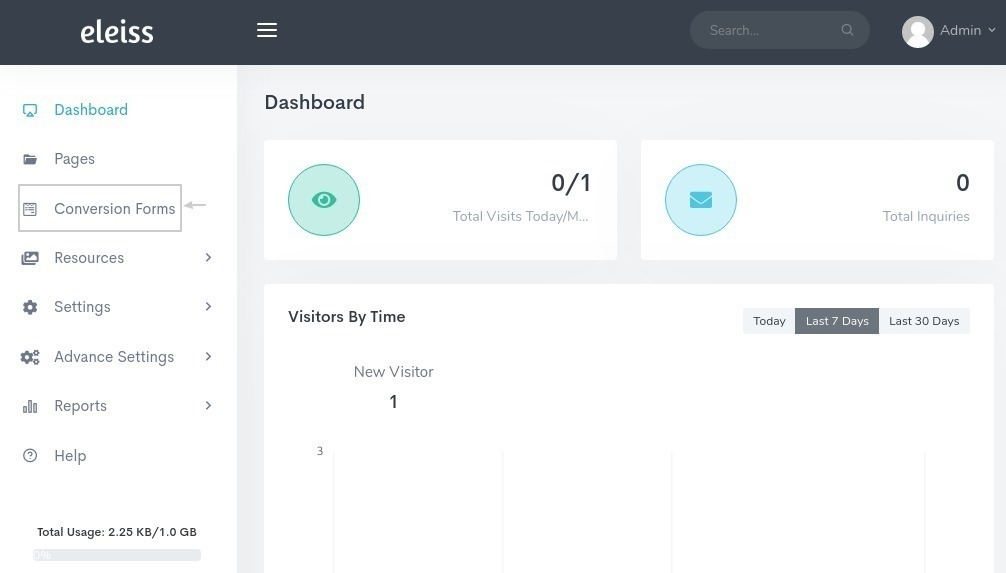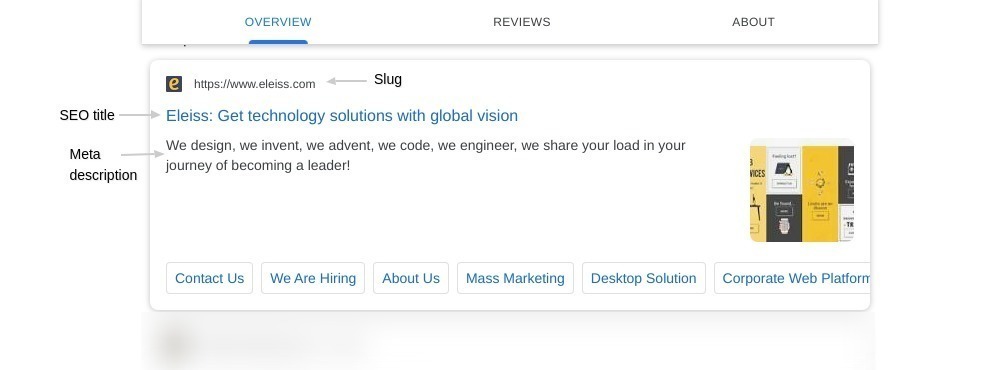Add Inquiry Forms¶
Who doesn’t like to give their opinion? One powerful (yet underestimated) way to build long lasting relationships with your customers is to ask for their feedback. Adding a form to your site makes sure that visitors have a safe place to share their thoughts about your products, services, website or support. Plus, this makes for golden material that you can add to your testimonials section. Important: Limit the number of fields to only essential information, as the more you ask, the less likely customers are to fill in your form.
To add a form, Go to ‘Conversion Forms’ from Menu and click on ‘Add Conversion Form’.


Add details into ‘General’ Tab and to add fields goto ‘Fields’ tab and Select appropriate fields and add them. Details which can be managed into ‘General’ Tab is as follows,
Set form name
Set form slug
Select form template
Set text for action/submit button
Set success message after visitor submits the form successfully
Set error message when visitor submits the form and some error occurs
Do/Don’t receive mail notification for generated inquiries
Set Page Redirects : Page redirection after form gets successfully submitted !!
📝 List of form fields supported in your system.

After adding forms you will be able to use them while adding a page.
Choose Template¶
System mainly provides types of templates according to plan you choose. All users by default get below templates,
Default template - default template for website which supports different types of modules. You have freedom to design whole page according to their requirement.
Contact template - contact information will be asked and provided details will set automatically.
Gold and Diamond plan users get Blog template using which they can write blogs on their website easily.
So, choose appropriate template and start adding content to it.
Add Right Pages¶
Your Web Platform contains many modules for presenting your thought on your website. And you don’t need to worry about how your website look in different devices and browsers. By default our all modules are responsive in all devices and supported in every browsers.
All you need to do is, select appropriate module and add content to it.

So, start selecting the module from ‘Content’ tab and add content according to given instructions in Web Platform.
Every business is unique, and so is every website. Yet, there are some traditional categories that every visitor expects to see. Here are the must-have pages any website needs:
The homepage: You only have one chance to make a good first impression. Because it’s the first thing visitors will see, your homepage needs to have a clean and organized look. Only keep the most crucial information: your logo, your business, your slogan (if you have one), and a button inviting visitors to browse further. Make sure all of this info appears above the fold (the section of your site that is visible to visitors without having to scroll down), as it’s the part of your page that loads first.
Your product or service page: This is where the magic happens. Here, your visitors discover what you have to offer, and if they are convinced, take their credit card out to purchase. The core recommendations for this category: Add high quality and real images, describe your products/services as precisely as you can, and be explicit about your conditions (shipping, return policy, etc.).
The aboutpage: Tell your story, your values, your methods, and every other piece of info that helps to depict your brand. Favor the first person (“I” or “We”), as it makes things more personal, and add a touch of humor if it suits your purpose. Also, don’t forget to add a picture of yourself or of your team members, since clients always like to see the (pretty) face behind the business relationship.
The contact section: There is a limit to how much contact information can appear on a clean and navigable website. The must-haves: Your phone number, postal address, email and social accounts (Facebook, YouTube, Twitter, etc.).
Extras (but highly recommended):
A blog: Creating a blog boosts your reputation as an expert, helps you gather a loyal community, and is extremely good for your website’s SEO. So you don’t have the imagination of Philip Roth? Don’t fret, you have much more to say than you think. You can talk about your clients (success stories, case studies, interviews) or yourself (events you attend, new employees, etc.). But the most fruitful is to share your expertise. Your readers will love to discover the tips, methods and hacks you use to solve the problems you (and maybe they) meet.
Testimonials: 69% of consumers would recommend a company to others after a good customer experience. Leverage the power of word-to-mouth and let your clients do the selling for you.
Do Your SEO¶
Getting your website on Google depends on a lot of factors - it’s known that there are over 200 signals that make up algorithms for ranking websites, such as the quality of your content. Or the competitiveness of your industry. Or the number of links that other websites send to yours (backlinks). SEO (search engine optimization) is a science in its own right, which requires time, patience, and persistence in order to get your first results.
Yet, there are many steps you can (and should) already take, while creating your pages. They will ensure that your website is built according to the best SEO guidelines, giving the content you publish the best chance to be found and properly ranked:
Keywords: To find your keywords, start by asking yourself what kind of questions a potential visitor might search for in Google to find a website like yours. Once you have them, pick one main keyword, and a couple of secondary ones - but no more than that. Place your keywords in the strategic locations of your site (SEO title and description, homepage, etc.), but don’t overdo it! Search engines penalize websites that “stuff” keywords unnaturally in their content.
On-page SEO: This scary concept simply means that you need to tell search engines what your pages are all about. For every one of them, your website builder will ask you to fill the meta-data: the URL, the SEO title (the blue link you see on Google’s list of results) and the description. Even though they cannot be seen by your website’s visitors, these elements are critical when it comes to being ranked, and shouldn’t be overlooked.
Hierarchy: Google bots like well-structured pages. Give some hierarchy to your text by putting the important content first, and building your text around headers of different levels and concise paragraphs. On top of improving your SEO, it will please your visitors, who are more and more inclined to skim read websites.
Local SEO: If you own a brick-and-mortar shop (an office, a store, a studio, etc.), you want your website to appear at the top of the results of people in your geographic area. Register to Google My Business for a chance to be found on Google Maps, make your contact info consistent across all your online channels, and optimize your mobile site. This convenient guide shows you how to make the most out of your local SEO and boost your foot traffic.
Internal linking: The more your pages are inter-connected, the easier it is for bots to navigate through your website. Add links to relevant locations of your text, inviting people to discover more pages.
To add content for SEO, you need to go to ‘SEO’ tab. In that you need to add page title, URL, SEO title and meta description. In the SEO tab only you can decide weather to display that page on menu or not. Weather you want to show breadcrumb on page or not. (After 2nd child page breadcrumb will automatically get displayed on website)

To display page on website menu mark the checkbox ‘Show in Menu’

To disable breadcrumb on page mark the checkbox ‘Disable breadcrumb on this page’

Know how your added SEO content will be used when visitors search your company or related products/services on Google!! Below is just an example that how your added page SEO title, meta description, slug will get displayed on google search result.

By reading SEO title and meta description Google will index your page in search result and visitors will click that link. So, try to add meaningfull and quality SEO content for your website’s pages.
Publish¶
Publish - and get back to it
After adding content for a page and search engine, now you can publish this page on website or either you can save this page as ‘Draft’. Later you can make changes on that page and make it live.
If you think you’re finished after your website has gone live, think again. Re-open your website editor (your best friend, by now), because there’s always room for improvement. Indeed, visitors are pretty picky when it comes to deciding whether a website is worth a browse or not. They want content that is original and valuable, but also content that is fresh.
